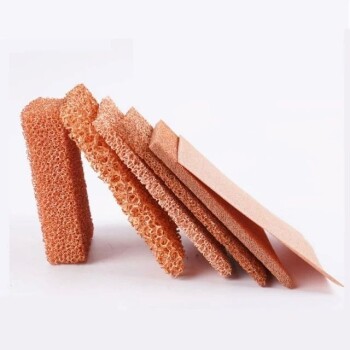In short, a CVD diamond is a lab-grown diamond created using a process called Chemical Vapor Deposition. Unlike diamond simulants like cubic zirconia, a CVD diamond is not a fake; it is chemically and physically identical to a diamond mined from the earth. The process essentially "grows" a diamond from a seed crystal using carbon-rich gases in a controlled chamber.
The core concept to understand is that CVD is a manufacturing method, not a type of material. It produces a diamond that is atomically identical to a natural one, differing only in its origin—a laboratory instead of the earth's mantle.
How a CVD Diamond is "Grown"
The Chemical Vapor Deposition process is a sophisticated technique that replicates natural diamond formation but on an accelerated timeline. It can be thought of as a form of atomic "3D printing" where carbon atoms are stacked layer by layer.
The Diamond Seed: The Foundation
The process begins with a very thin slice of a high-quality diamond, known as a diamond seed. This seed acts as the template or foundation upon which the new diamond will grow.
The Deposition Chamber: The Environment
This seed is placed inside a sealed, vacuum-tight chamber. The chamber is then heated to extreme temperatures, typically around 800°C, creating the necessary conditions for diamond formation.
The Carbon-Rich Gas: The Building Blocks
The chamber is flooded with a mixture of gases rich in carbon, such as methane, along with hydrogen. These gases provide the fundamental atoms needed to build the diamond crystal.
Ionization and Growth: The Process
High-power energy, often from microwaves, is introduced into the chamber. This ionizes the gas, creating a plasma that breaks down the gas molecules. This process frees the carbon atoms, which then rain down and bond to the diamond seed, replicating its crystal structure.
Over a period of two to four weeks, these carbon atoms accumulate, and the diamond "grows" into a complete, high-quality crystal.
Are CVD Diamonds Real Diamonds?
This is the most common point of confusion. From a scientific standpoint, the answer is an unequivocal yes.
Identical Chemical and Physical Structure
A CVD diamond has the same crystal lattice and carbon atom composition as a natural diamond. It shares the same properties, including exceptional hardness (8,500 kgf/mm2), thermal conductivity, and optical brilliance. Its properties can be equivalent to a natural diamond up to 99%.
The Role of Grading and Inscriptions
To ensure transparency, reputable gemological labs grade CVD diamonds just as they do natural ones. These diamonds are laser-inscribed on their girdle with a note, such as "lab-grown," and a report number to clearly identify their origin.
Subtle Differences for Experts
While indistinguishable to the naked eye, a trained gemologist using specialized equipment may be able to spot subtle indicators of the growth process. The plasma used in the CVD method can sometimes cause a faint hazy or milky appearance under very high magnification.
Understanding the Trade-offs and Applications
CVD technology is not just for jewelry; its unique properties make it valuable for demanding industrial and scientific applications.
Industrial Strength and Performance
CVD diamonds are used to create cutting tools for non-ferrous materials. The tool life of a CVD diamond tool is often 2 to 10 times longer than that of Polycrystalline Diamond (PCD) tools, demonstrating superior wear resistance.
A Key Limitation: High-Temperature Cutting
The primary industrial limitation of CVD diamond is its unsuitability for cutting steel. The high temperatures generated during steel machining can cause a chemical reaction that effectively melts the diamond, leading to rapid tool wear.
Making the Right Choice for Your Goal
Understanding the origin and properties of a CVD diamond allows you to choose wisely based on your specific needs.
- If your primary focus is jewelry: A CVD diamond provides the exact same visual brilliance and physical durability as a mined diamond, distinguished only by its origin.
- If your primary focus is industrial tooling: CVD offers a significant performance and longevity advantage over PCD for machining non-ferrous metals and composites.
- If your primary focus is scientific research: The CVD process allows for the creation of exceptionally pure diamonds with tailored properties for advanced optical or electronic applications.
Ultimately, a CVD diamond is a testament to human ingenuity—a true diamond created through a controlled and precise scientific process.
Summary Table:
| Property | CVD Diamond | Natural Diamond |
|---|---|---|
| Chemical Composition | Pure Carbon (C) | Pure Carbon (C) |
| Hardness | 8,500 kgf/mm² | 8,500 kgf/mm² |
| Origin | Lab-Grown | Mined from Earth |
| Growth Time | 2-4 weeks | Billions of Years |
| Key Application | Jewelry, Industrial Tools, Research | Primarily Jewelry |
Ready to leverage the precision of lab-grown diamonds for your projects? KINTEK specializes in high-performance lab equipment and consumables, including CVD technology, to support your research and industrial applications. Whether you're in jewelry manufacturing, materials science, or need durable cutting tools, our solutions ensure quality and efficiency. Contact our experts today to discuss how CVD diamond technology can enhance your work!
Related Products
- Custom CVD Diamond Coating for Lab Applications
- CVD Diamond Domes for Industrial and Scientific Applications
- Cylindrical Resonator MPCVD Machine System Reactor for Microwave Plasma Chemical Vapor Deposition and Lab Diamond Growth
- CVD Diamond Cutting Tool Blanks for Precision Machining
- CVD Diamond Optical Windows for Lab Applications
People Also Ask
- What is the formula for thickness of coating? Accurately Calculate Dry Film Thickness (DFT)
- Is diamond coating permanent? The Truth About Its Long-Lasting Durability
- What are the properties of diamond coating? Unlock Extreme Performance for Your Components
- What are the advantages of diamond coating? Boost Durability and Performance
- What are the three types of coating? A Guide to Architectural, Industrial, and Special Purpose




















